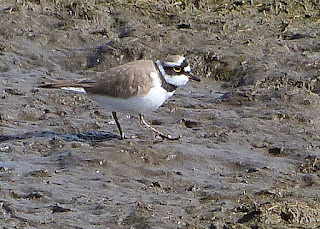 |
| Little ringed plover - Aldcliffe |
So when I clapped eyes on a lovely adult female on the Flood this morning I wasn't the least bit surprised.
These dainty little waders are long distance migrants, returning to the UK each spring from their wintering grounds in Africa. They are as much a herald of spring for me as wheatears, sand martins and chiffchaffs.
(The pic here was taken previously).
Today's morning visit to Aldcliffe followed a few off-patch visits along with fellow birder and good chum Stuart Meredith. First we headed to Sizergh Castle in search of hawfinch. These dazzling and often elusive birds are regular at this site and we weren't disappointed. Arriving around 6.30am we had just a short wait before being treated to superb views of a pair of birds feeding on the ground. Although I have seen this species at Sizergh before these were by far the best views I've ever had of hawfinch. A severe blizzard of hail covered the car park in a carpet of white and signaled our time to leave!
For details of this great site visit: Sizergh Hawfinches
A stop at Leighton Moss (including breakfast in the cafe) added 3 egret species to the day's list; cattle, great (2) and little (enough). Around 50 sand martins were visible from the Causeway Hide as they hawked over the water while water rails squeeled from the depths of the reedbeds. A pair of marsh harriers showed well and 10 pochard (an increasingly scarce sight these days) were on the mere.
At least 8 avocets were on the Allen Pool.
We then headed to Heysham where were looked for the Iceland gull at the Harbour. We soon located it having a snooze on the roof of one of the harbour-side buildings. Not the best of views, but good enough.
After our first drop-in at Aldcliffe we moved on to Bradshaw Lane, Pilling. This area is well known among local birders for the farmland bird feeding initiative that has been running here for many years. The feeding stations attract many species including several that are difficult to find in this region. We were blessed with great views of multiple yellowhammers and tree sparrows plus a single brambling.
A brief return to Aldcliffe (after tea and cake at Ashton Hall) revealed that the little ringed plover was still present.
All in all we enjoyed a good trundle around the area and I added a few new birds to my slowly increasing yearlist and possibly a few new inches to my waistline...
Jon






